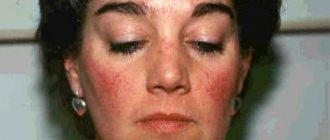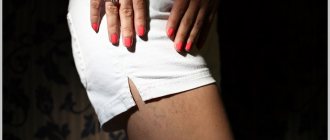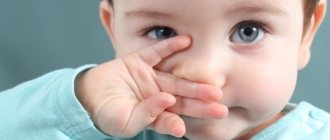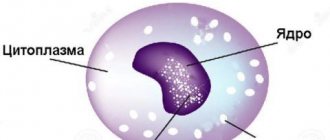+RU
Consultation with a Phlebologist in Moscow, Articles, Reviews of Clinics
Join us and follow the news on social networks
The appearance of a vascular network on the skin always worries a person. Such a manifestation is not only a cosmetic defect, in some cases it indicates serious health problems. For example, rosacea can occur in children with liver dysfunction.
What does the vascular network on a child’s face indicate, what measures need to be taken and how to eliminate it? Answers to such questions are presented in detail in the text of the article.
Why does redness appear?
- Causes of manifestation
- Features of manifestation
- How to get rid of a violation
- Proven methods Sclerotherapy
- Laser coagulation
Types of rosacea
Subcutaneous visible networks can be formed by vessels of various functional purposes, and can be arterial, venous and mixed. In the first case, red vessels often appear on the face. Blue-colored venous networks mainly occur on the trunk and lower extremities. When both types of blood formations are expanded at the same time (in this case they speak of a mixed type), they are distinguished by a bluish color, closer to a violet hue. Such spots are located on open areas, especially on the face, mainly on the cheeks.
Classification of telangiectasia
The appearance of telangiectasia can take different forms. The color of these formations is most often red, but can also have a bluish or purple tint.
Spider veins come in different colors and sizes
These manifestations can be pronounced or very slight. In some cases, they are mistaken for a skin defect. In order not to miss the onset of a serious illness, at the first signs of TAE formation you need to be examined by a specialist.
According to their appearance, TAEs are:
- point. They form anywhere on the body and can have different shades of red and blue;
- linear. They form most often on the face, sometimes on the legs. Colors – all shades of red;
- arachnids. Appear on different parts of the body. They are supplied with blood by the smallest arteries, the color of the formations is red.
- tree-like. Formed on the thighs and legs. The shape resembles a branched tree crown, hence the name. Color - red or with a bluish tint.
There are several types of TAE
According to their origin, TAEs are:
- venous. They form a thin network of veins on the skin. The pattern resembles the shape of stars;
- arterial. Such telangiectasias have the shape of a spider with a center and branches in all directions. Color – red;
- capillary. They are usually placed on the face. In appearance, capillary TAEs can be linear or tree-like. Color – red or red-violet.
TAE is also divided by origin
Causes of vascular networks on the face in children and adults
In most situations, hereditary predisposition plays a role, especially when it comes to venous formation under the skin. Spider veins on a child’s face often appear during a sharp hormonal surge, which occurs during adolescence.
A genetic tendency to the appearance of a subcutaneous mesh of mixed and arterial type also occurs. This can be seen in the example of people who work under the same conditions (representatives of a number of professions, for example, steelworkers, are prone to constant expansion of small subcutaneous vessels). While in some people rosacea occurs in childhood, in others it occurs closer to retirement or does not make itself felt at all.
Provoking factors
In addition to predisposition, the main causes of dilated blood vessels, especially on the face in children, are the following factors:
- Exposure of children's exposed skin to high temperatures.
- The influence of atmospheric influences and ultraviolet radiation on a child’s skin.
In adults, this symptom is a consequence of drinking alcohol. Against this background, the vessels expand sharply, remaining so until the effect of ethyl alcohol wears off completely. In the event that alcohol is consumed daily, the blood vessels become constantly dilated over time, which leads first to constant skin redness, and then to a clear manifestation of venous and arterial networks of a mixed type. It is for this reason that, against the background of chronic alcoholism, people’s faces acquire a bluish tint.
Frequent exposure to high temperatures occurs among representatives of a number of professions (whether workshop workers or grain growers). In children, the reason for exposure to high temperatures is the desire to regularly take a hot bath or shower. Traces of ultraviolet radiation and atmospheric influences can be seen in children who spend a lot of time in the sun, sunbathe and do not hide their face under a hat.
Another reason may be dermatitis and allergies, which negatively affect the condition of the skin. At the same time, the skin becomes thinner, the tone of the dermis decreases, and reactions of superficial vascular formation are provoked. In the presence of a hereditary predisposition, all this inevitably leads to rosacea, especially on the cheeks.
Stages of pathology formation
The first stage is the least problematic for the patient. It does not even cause cosmetic inconvenience. Redness and spots on the skin occur exclusively after the influence of vasodilating conditions: thermal procedures, sunbathing or drinking alcohol. Soon the capillaries return to normal, the redness disappears until the next attack.
The second stage - the vessels are thoroughly affected and, as a result, do not narrow. The patient may complain to the doctor about the non-disappearing vascular pattern, as well as dry skin. It is easier to provide assistance directly at this stage. However, it is necessary to start treatment in a timely manner.
The third stage - small capillaries are affected, poorly saturated with oxygen, and blood circulation is disrupted. Congestive and inflammatory movements and the appearance of rosacea are likely. This stage will require the most serious approach and long-term complex therapy.
How to overcome dilated blood vessels
At a more serious stage, other methods of treating spider veins are used:
- Phototherapy makes it possible to cover wider areas of the skin, and in addition, simultaneously carry out a complex procedure: rejuvenation, relief from pigmentation and inflammation. This procedure is one of the most expensive and time-consuming. The course of treatment is twelve sessions;
- Ozone therapy. The procedure is performed in such a way that an oxygen-ozone mixture is injected into the lumen of the vessel. The course of treatment is about five sessions;
- Mesotherapy. This procedure refers to the injection of drugs under the skin to strengthen blood vessels. This option refers to the final stage of treatment for spider veins. The course of treatment lasts no more than ten sessions;
- A method of radio wave surgery based on a non-traumatic method of sticking together particles of a colloidal system during collisions during thermal movement. The vessels are cauterized by high-frequency waves. Used to treat rosacea;
- Laser coagulation is characterized by gluing of capillary walls under the influence of a laser beam. The blood flow at the site of influence temporarily stops, and the cosmetic defect gradually disappears. The results after the procedure can be seen after a couple of weeks. The possibility of reoccurrence is excluded. There is no regeneration stage, and slight redness goes away over the course of days. The course of treatment is about six procedures.
Most popular: Wow effect and youthful appearance for a penny with a peeling roll
To maintain the result, it is recommended to periodically conduct courses of lymphatic drainage and plastic massage, visit a cosmetologist and carry out proper skin care.
What other factors cause the appearance of stars in children?
Among the many known causes of capillary fragility, the most common for babies are:
- Influence of genetic factor. If the baby’s parents have been diagnosed with fragile capillaries, then the likelihood that similar spider veins will also appear on the child’s face also increases.
- The presence of dysfunction of internal organs. When a child is diagnosed with diseases of certain internal organs, such as the liver, the risks of a similar problem also increase.
- The influence of temperature changes. Spider veins in babies can appear on the face as a result of regular changes in ambient temperature. For example, when visiting several countries with different climatic conditions.
- Due to mechanical damage to the skin. For example, such damage may occur due to manual skin cleansing of pimples or blackheads.
- Poor nutrition. Constant overeating and inactivity of a child can lead to capillaries bursting and, thus, rosacea is activated. Preschool children require a balanced diet, which affects the proper functioning of important organs.
A photo of spider veins on a child’s face is presented below.
Types of the disease and how to recognize it
Spider veins appear on the surface of the cheeks, wings of the nose and in the chin area. On the forehead, a capillary network occurs in rare cases. The affected areas of the skin begin to change color from light pink to blue, depending on the severity of telangiectasia on the face. Before starting treatment, it is necessary to confirm the diagnosis.
Visually, several types of the disease are distinguished:
- linear, or sinusoidal;
- tree-like;
- star-shaped;
- spot-like.
Cuperosis develops gradually, so the dynamics of the disease are divided into 4 main stages. Each stage has characteristic symptoms.
| Stage of disease development | Signs of pathology |
| Stage 1 | The sensitivity of the skin of the cheeks, nose and lower jaw area begins to increase. The epithelium begins to turn red, and erythrosis develops. After the onset of rosacea on the facial skin, a person begins to complain of increased temperature, itching and colic. The duration of symptoms varies from 2 minutes to 2 hours. The pathology may spread to the neck. |
| Stage 2 | Redness stops disappearing and is constantly present on the skin. A network of capillaries and pigmentation gradually appear. |
| Stage 3 | Dermatosis develops. The skin begins to lose elasticity and becomes pale. An inflammatory process occurs in the affected areas, in rare cases accompanied by a pustular rash. This phenomenon is observed only 20-30 years after the onset of the disease. |
| Stage 4 | The skin begins to roughen and thicken, especially in the nose area. |
Important information: How to use Darsonval for rosacea on the face
What determines the appearance of stars on the face of children?
Regarding children, we can say that in their case the situation with vascular subcutaneous manifestations is ambiguous. Firstly, a lot depends on the age of the baby. In addition, rosacea in a child can manifest itself only in exceptional cases, due to the fact that the skin, along with the walls of the blood vessels in children, is very elastic. Thus, persistent vascular dilation cannot just happen.
The exception is adolescence, when there is excessive hormonal imbalance and vascular formations appear on the skin. It is worth noting that the expansion of blood subcutaneous formations among adolescents in most situations is exclusively transient.
Among other things, if a child develops asterisks with subcutaneous vascular networks, then you need to think about other conditions. Spider veins, often appearing on the limbs and torso, can signal problems with various internal organs. Usually, after the provoking disease is cured, the child’s asterisks go away on their own.
Treatment of the disease
- Sclerotherapy, when sclerotosan is injected into the vessel. After use, swelling may be observed, which will go away on its own over time. The appearance of burst blood vessels on the limbs or in other places requires wearing compression garments.
- Laser exposure. A painless method of getting rid of symptoms. The laser is directed onto the mesh and blood circulation is restored. Does not cause skin damage and affects even the smallest capillaries.
Drug therapy for rosacea is necessary only in cases of diseases caused by disruption of the internal organs and endocrine system. If the disease is caused by external factors, then it is enough to eliminate them and reduce the impact on the body. Minimally invasive treatment methods are used for rosacea that has become threatening, in which the vessels actively burst without any particular reason. In addition to targeted therapy methods, the patient is recommended to follow several skin care rules:
- It is not recommended to use cleansing cosmetics or use a hard towel.
- You should treat your skin only with proven creams to moisturize and prevent microcracks in the skin.
Hemangioma
The disease, which is mistakenly mistaken for rosacea, in children usually turns out to be a benign neoplasm, which is called hemangiomas. This disease does not pose any threat to health, but it is very unpleasant due to cosmetic defects. Before solving such a cosmetic problem in specialized salons, it is imperative to consult an oncologist.
Therapy for stars on the face in children
Parents are wondering how to get rid of spider veins on their child’s face and which doctor to contact.
What should be done if six months have passed and the redness on the child’s face has not disappeared at all? First, you must consult a doctor. After ordering an examination and clarifying the individual characteristics of the body, along with possible contraindications, the specialist will certainly suggest one of the methods of therapy.
With a spider vein on a child’s face, which doctor should he consult? The pediatrician will come to the rescue.
Photos before and after
Photos before and after sclerotherapy for spider vein removal
Photos before and after electrocoagulation to remove spider veins
Photos before and after using the Surgitron device to remove spider veins
Photos before and after laser photocoagulation for spider vein removal
special instructions
It is important to understand that therapy for rosacea through local treatment (using ointments, lotions or compresses) in children is not only ineffective, but also dangerous. It is necessary to keep in mind the fact that at an early age the sensitivity of the skin is increased, and its reaction to drugs can be quite problematic to predict. We must also not forget about the possible allergic reaction of the child’s body to herbs and medications.
Treatment of spider veins on the face of a child
Modern methods of treating the problem in children include:
- Carrying out sclerotherapy. This minimally invasive treatment method does not require skin incisions, and, in addition, does not involve any traumatic surgical intervention. The essence of this procedure is that a thin needle with a special sclerotizing component is inserted into the damaged vessel. The sclerosant acts on the inner capillary membrane and initially destroys it, and then leads to gluing of the vascular wall. As a result of this, the lumen of the vessel immediately narrows and as soon as the swelling subsides, the spider veins disappear. To prevent such a phenomenon as telangiectasia from appearing again, doctors recommend wearing shapewear for the first time after sclerotherapy, and, in addition, not touching your face. Another way to get rid of spider veins on a child’s face?
- Performing laser coagulation. This procedure is carried out using a special laser that heats the blood in the affected area to seventy degrees Celsius. Thus, gluing of the vessel walls is achieved. The main advantage of laser treatment is that it has no effect on the surrounding tissue and blood vessels, and the red veins disappear immediately after the end of laser coagulation.
How to treat spider veins on a child’s face is now clear.
How to get rid of a violation
Cuperosis in infancy is most often a temporary phenomenon. The child’s body adapts over time and reacts less pronouncedly to various changes.
Attention! Parents often think about how to remove spider veins from their child. Experts have different opinions about the need for this manipulation, but the vast majority assures that the defect will disappear on its own over time, and there is no need to use radical means.
The child’s diet must be saturated with useful components.
Cuperosis that appears in childhood can disappear on its own, but in order for the process of restoring the integrity of the capillaries to proceed faster, the body needs help. This is extremely simple to do; the main task of parents is to balance the child’s diet.
The menu must include the following vitamins:
- A;
- AT 5;
- WITH;
- R;
- TO.
The impact of such components on the child’s body is discussed in the table:
| How to normalize a child's diet | ||
| Vitamin | Action | Characteristic image |
| Vitamin A (retinol) | Provides elasticity to the walls of blood vessels. The component is contained in the following products:
Fish oil, which acts as an essential source of retinol, should also be included in your baby’s diet. |
|
| Vitamin B5 (panthenic acid) | The component ensures restoration of vascular tone. Patients should pay attention to the fact that such a substance is absorbed only in combination with vitamin C. A child’s body can obtain a similar substance from the following foods:
|
|
| Vitamin C | You can get your daily dose of ascorbic acid from the following fruits:
It is necessary to introduce citrus fruits into the baby’s diet carefully; it is important to exclude the possibility of allergies. Vitamin C can also be purchased at the pharmacy in pill form. The instructions regulate the optimal dosage according to age. The price of the nutritional supplement is low. |
|
| Vitamin P (rutin) | Many common fruits and vegetables are sources of this component. The component ensures the process of strengthening and restoring vascular tissues, preventing them from deforming as a result of exposure to negative factors. Among the list of products containing rutin are:
|
|
| Vitamin K | The component takes an active part in the processes of prothrombin production. The substance ensures the processes of blood clotting. The component can be obtained from the following products:
|
|
The video in this article will introduce readers to the main causes of rosacea in children. Why blood vessels burst on a child’s face is already known. The fact has been established and confirmed that such a defect can be eliminated by normalizing nutrition.
A child needs to be instilled with a love of a healthy lifestyle from childhood.
Attention! It is also important to protect the skin from negative factors.
It is necessary to resort to the use of radical means only if simple methods are ineffective.











